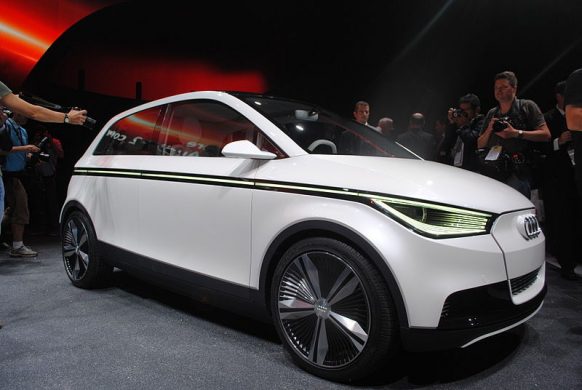German automobile manufacturer, Audi is working with China's Hanergy Thin Film Power Group towards inventing a way to integrate solar cells into panoramic glass roofs to be embedded in a series of future Audi electric vehicles.
The announcement came straight from Audi, which issued an official statement last week with all the details about the innovative collaboration.
Alta Devices, a subsidiary of Hanergy Thin Film Power Group will work with Audi to manage to integrate thin-film solar cells into a panoramic glass roof.
At a more advanced stage, the two companies aim to come up with a way of covering the entire rooftop with solar cells.
Positve impact on the car´s range
The ultimate aim is for the electric vehicle to gain efficiency, with the electricity generated feeding the car’s electrical system or, for example, the air-conditioning system or the seat heaters- a development that is expected to have a direct positive impact on the car’s range.
Dr. Bernd Martens, Audi Board of Management Member for Procurement said: “The range of electric cars plays a decisive role for our customers”.
He added: “Together with Hanergy, we plan to install innovative solar technology in our electric cars that will extend their range and is also sustainable”.
The true revolution though will be when the electricity produced will be able to directly charge the traction battery.
“That would be a milestone along the way to achieving sustainable, emission-free mobility”, Dr. Martens said.
Dr. Ding Jian, Senior Vice President of Hanergy Thin Film Power Group, CEO of Alta Devices Inc., and co-leader of the Audi/Hanergy Thin Film Solar Cell Research and Development Project, said: “This partnership with Audi is Alta Devices’ first cooperation with a high-end auto brand”.
He added: “By combining Alta’s continuing breakthroughs in solar technology and Audi’s drive toward a sustainable mobility of the future, we will shape the solar car of the future”.
Efficiency rate og 25%
The solar cells which will be produced by Alta Devices in California, are expected to have an efficiency rate of 25%, and operate well under low-light and high-temperature occasions.
The first prototype of the endeavour will be ready by the end of 2017.
Audi, which was involved in an emissions-scandal- including car recalls, prosecutor investigations and persistent criticism from unions and managers, is looking to make a business shift towards EVs.
As it announced last month, it aims to fund this shift by cutting $12b in costs by 2020.
Audi is planning to deliver three battery-electric models by 2020 and aims to cover one third of its vehicle sales with fully electric drivetrains by 2025.
Gaining ground
The combination of solar power with electric vehicles is an endeavour that has already started gaining ground, with Japan’s Panasonic already producing a 180w array of solar cells able to be fixed to the roof of an automobile and Nissan offering an add-on solar panel option for its Leaf electric car.
The ultimate aim is for the electric vehicle to gain efficiency, with the electricity generated feeding the car’s electrical system or, for example, the air-conditioning system or the seat heaters- a development that is expected to have a direct positive impact on the car’s range.
Dr. Bernd Martens, Audi Board of Management Member for Procurement said: “The range of electric cars plays a decisive role for our customers”.
He added: “Together with Hanergy, we plan to install innovative solar technology in our electric cars that will extend their range and is also sustainable”.
True revolution
The true revolution though will be when the electricity produced will be able to directly charge the traction battery.
“That would be a milestone along the way to achieving sustainable, emission-free mobility”, Dr. Martens said.
Dr. Ding Jian, Senior Vice President of Hanergy Thin Film Power Group, CEO of Alta Devices Inc., and co-leader of the Audi/Hanergy Thin Film Solar Cell Research and Development Project, said: “This partnership with Audi is Alta Devices’ first cooperation with a high-end auto brand”.
He added: “By combining Alta’s continuing breakthroughs in solar technology and Audi’s drive toward a sustainable mobility of the future, we will shape the solar car of the future”.
The solar cells, which will be produced by Alta Devices in California, are expected to have an efficiency rate of 25%, and operate well under low-light and high-temperature occasions.
The first prototype of the endeavour will be ready by the end of 2017.
Audi, which was involved in an emissions-scandal- including car recalls, prosecutor investigations and persistent criticism from unions and managers, is looking to make a business shift towards EVs.
As it announced last month, it aims to fund this shift by cutting $12b in costs by 2020.
Audi is planning to deliver three battery-electric models by 2020 and aims to cover one third of its vehicle sales with fully electric drivetrains by 2025.
The combination of solar power with electric vehicles is an endeavour that has already started gaining ground, with Japan’s Panasonic already producing a 180w array of solar cells able to be fixed to the roof of an automobile and Nissan offering an add-on solar panel option for its Leaf electric car.















